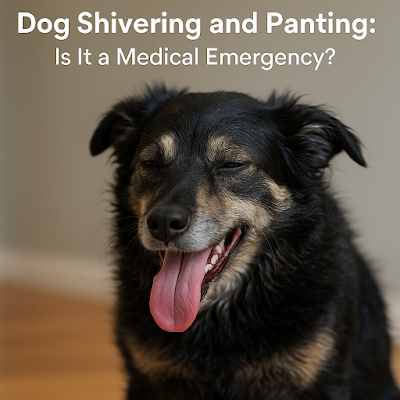Dog Shivering and Panting: Is It a Medical Emergency?
Seeing your dog shivering and panting can be alarming. Is it anxiety, pain, or something more serious? This guide dives deep into the possible causes, what you can do at home, and when it’s time to call the vet. Read on to protect your furry friend with the knowledge every dog owner needs.
Understanding the Symptoms: What Does Shivering and Panting Mean?
Dogs shiver and pant for various reasons—some harmless, others life-threatening. Panting helps regulate body temperature, while shivering can signal fear, cold, or pain. However, when both occur together, it's often a sign of physical or emotional distress.
- Shivering: Involuntary muscle movements that can indicate cold, pain, or anxiety.
- Panting: Rapid breathing often related to heat regulation, stress, or medical conditions.
Top 10 Causes of Dog Shivering and Panting
1. Anxiety or Stress
Thunderstorms, fireworks, separation, or a new environment can lead to anxiety. Dogs may tremble, pant, hide, or become clingy.
2. Pain or Injury
Dogs often hide their pain. Panting and shivering may be the only clues. Look for limping, flinching, or reluctance to move.
3. Fever or Infection
A fever can cause shivering and panting. Common infections include respiratory infections, urinary tract infections, or internal abscesses. A dog’s normal body temperature ranges from 101°F to 102.5°F (38.3°C to 39.2°C).
4. Toxic Ingestion
Chocolate, xylitol, grapes, and medications can cause toxic reactions. Immediate symptoms include drooling, vomiting, shaking, and panting. This is a medical emergency.
5. Heatstroke
Dogs overheat quickly, especially in hot, humid weather. Excessive panting, bright red gums, shivering, or collapse are signs. Cool the dog immediately and head to a vet.
6. Cold Temperatures or Hypothermia
Small or short-haired dogs are prone to cold. Shivering is an early sign of hypothermia. Provide warmth immediately.
7. Generalized Tremor Syndrome (GTS)
Also known as “white shaker syndrome,” this neurological disorder mainly affects small white breeds. Symptoms include full-body tremors, often treated with corticosteroids.
8. Heart Disease
Heart conditions lead to poor circulation and oxygenation, causing panting and shaking. Look for coughing, exercise intolerance, or collapse.
9. Hypoglycemia (Low Blood Sugar)
Especially common in puppies and small breeds. Symptoms: trembling, weakness, disorientation, or collapse. Give honey or Karo syrup and visit a vet.
10. Old Age or Cognitive Dysfunction
Older dogs may experience trembling due to arthritis, neurological issues, or dementia. Nighttime pacing and confusion are common signs.
How to Respond at Home
Observe your dog calmly. Here’s what to do:
- Check for injury or swelling.
- Take your dog’s temperature.
- Offer water and a quiet space.
- Check the environment for stressors (loud noises, hot or cold areas).
- Never give human medications without a vet’s guidance.
If symptoms last more than 30 minutes or worsen, call your vet.
When to See a Veterinarian
Seek immediate care if your dog shows:
- Vomiting or diarrhea with shivering and panting
- Foaming at the mouth
- Seizures or collapse
- Gum color change (blue, pale, or bright red)
- Labored breathing
- Sudden weakness or inability to stand
Early intervention can save your dog’s life.
Preventive Measures
Here are practical tips to prevent episodes of shivering and panting:
- Exercise regularly to reduce anxiety and maintain heart health.
- Keep your dog indoors during extreme temperatures.
- Stay current with vaccinations and parasite prevention.
- Keep toxic substances out of reach.
- Visit your vet for routine checkups, especially for senior dogs.
What If It’s Just Emotional?
Some dogs are simply more sensitive. If your vet rules out medical issues, consider working with a canine behaviorist or trying:
- Thunder shirts or calming wraps
- Pheromone diffusers like Adaptil
- Natural calming supplements (under veterinary supervision)
Final Thoughts: Trust Your Gut
As a loving pet owner, your instincts are powerful. If your dog is acting off—trembling, panting, hiding—something is likely wrong. While some cases are mild, others may be emergencies. Don’t wait and hope for the best. Be proactive and don’t hesitate to contact your vet.
Your dog depends on you not just for love and care—but for protection and timely action. And with this guide, you’re already ahead.
FAQs: Dog Shivering and Panting
Why is my dog panting and shivering at night?
This could be due to fear, anxiety, pain, or even illness. Senior dogs may also experience nighttime anxiety or cognitive dysfunction.
Can a dog shiver and pant due to excitement?
Yes, excitement or overstimulation can cause temporary shaking and panting. If it passes quickly, it’s usually harmless.
Should I cover my dog if it’s shivering?
If your dog is cold, yes. Use a warm blanket, but monitor them—shivering can also mean pain or stress.
How long should I wait before calling the vet?
If symptoms persist for more than 30 minutes or are accompanied by other concerning signs (vomiting, lethargy, or collapse), call your vet immediately.
Can pain cause my dog to shiver and pant?
Absolutely. Dogs don’t always whine or yelp in pain. Shivering and panting are often signs of discomfort or injury.

